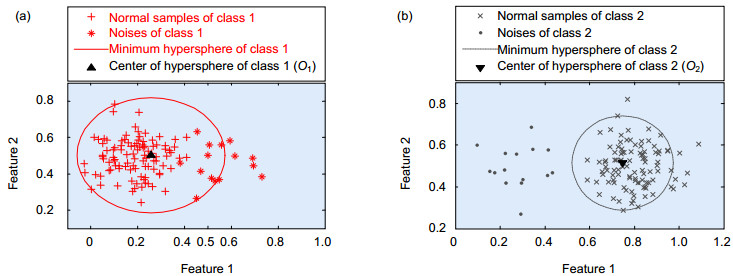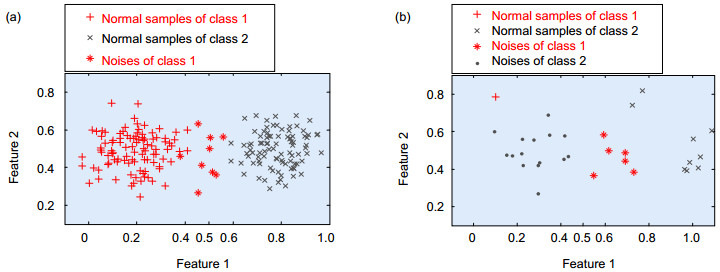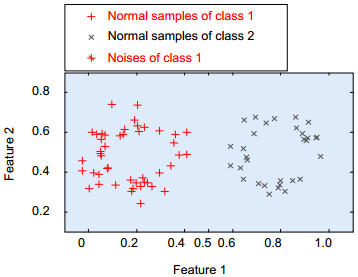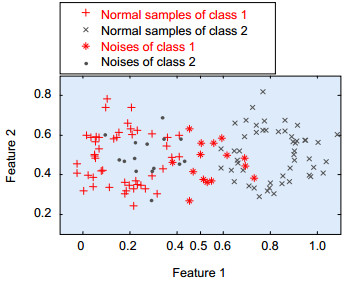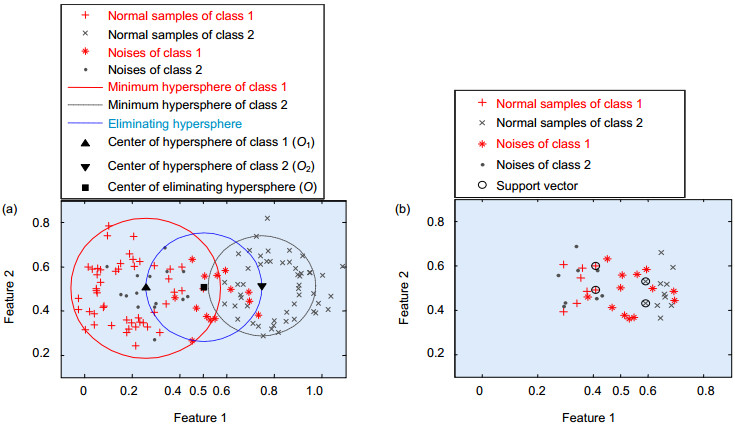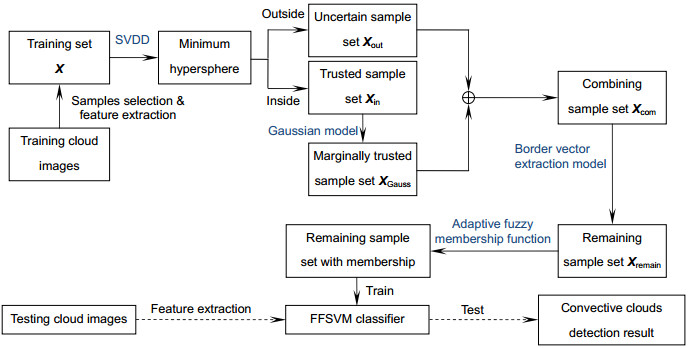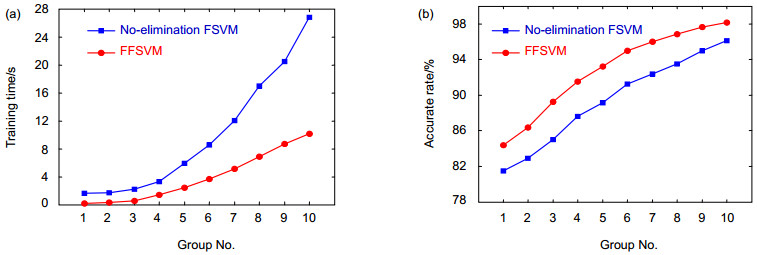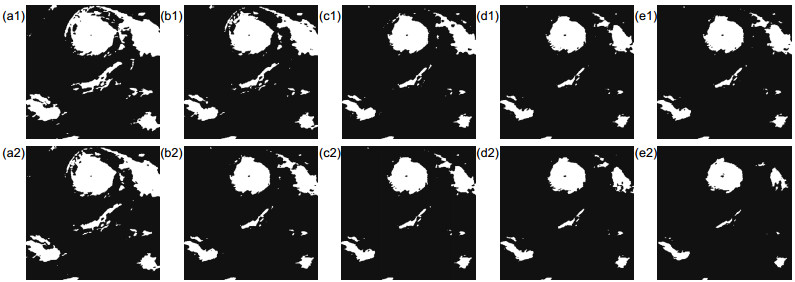| Citation: | Gong Fei, Jin Wei, Tian Wenzhe, et al. Convective clouds detection in satellite cloud image using fast fuzzy support vector machine[J]. Opto-Electronic Engineering, 2017, 44(9): 872-881. doi: 10.3969/j.issn.1003-501X.2017.09.003 |
Convective clouds detection in satellite cloud image using fast fuzzy support vector machine
-
Abstract
Support vector machine (SVM) is easily affected by noises and outliers, and its training time dramatically increases with the growing in number of training samples. Satellite cloud image may easily be deteriorated by noises and intensity non-uniformity with a huge amount of data needs to be processed regularly, so it is hard to detect convective clouds in satellite image using traditional SVM. To deal with this problem, a novel method for detection of convective clouds was proposed based on fast fuzzy support vector machine (FFSVM). FFSVM was constructed by eliminating feeble samples and designing new membership function as two aspects. Firstly, according to the distribution characteristics of fuzzy inseparable sample set and the fact that the classification hyper-plane is only determined by support vectors, this paper uses SVDD, Gaussian model and border vector extraction model comprehensively to design a sample selection method in three steps, which can eliminate most of redundant samples and keep possible support vectors. Then, by defining adaptive parameters related to attenuation rate and critical membership on the basis of the distribution characteristics of training set, an adaptive membership function is designed. Finally, the FFSVM is trained by the remaining samples using adaptive membership function to detect convective clouds. The experiments on FY-2D satellite images show that the proposed method, compared with traditional FSVM, not only remarkably reduces training time, but also further improves the accuracy of convective clouds detection.
-

-
References
[1] Chen Lin, Hu Xiuqing, Xu Na, et al. The application of deep convective clouds in the calibration and response monitoring of the reflective solar bands of FY-3A/MERSI (medium resolution spectral imager)[J]. Remote Sensing, 2013, 5(12): 6958-6975. doi: 10.3390/rs5126958 [2] Wang Wenhui, Cao Changyong. Monitoring the NOAA operational VIIRS RSB and DNB calibration stability using monthly and semi-monthly deep convective clouds time series[J]. Remote Sensing, 2016, 8(1): 32. doi: 10.3390/rs8010032 [3] Seiki T, Nakajima T. Aerosol effects of the condensation process on a convective cloud simulation[J]. Journal of the Atmospheric Sciences, 2014, 71(2): 833-853. doi: 10.1175/JAS-D-12-0195.1 [4] Yan Wen, Gong Fei, Zhou Ying, et al. Satellite cloud image fusion based on adaptive PCNN and NSST[J]. Opto-Electronic Engineering, 2016, 43(10): 70-76, 83. (in Chinese) [5] Zhou Ying, Fu Randi, Yan Wen, et al. A method of infrared nephogram super-resolution based on structural group sparse representation[J]. Opto-Electronic Engineering, 2016, 43(12): 126-132. (in Chinese) [6] Tapakis R, Charalambides A G. Equipment and methodologies for cloud detection and classification: a review[J]. Solar Energy, 2013, 95: 392-430. doi: 10.1016/j.solener.2012.11.015 [7] Roca R, Ramanathan V. Scale dependence of monsoonal convective systems over the Indian ocean[J]. Journal of Climate, 2000, 13(7): 1286-1298. doi: 10.1175/1520-0442(2000)013<1286:SDOMCS>2.0.CO;2 [8] Fiolleau T, Roca R. An algorithm for the detection and tracking of tropical mesoscale convective systems using infrared images from geostationary satellite[J]. IEEE Transactions on Geoscience and Remote Sensing, 2013, 51(7): 4302-4315. doi: 10.1109/TGRS.2012.2227762 [9] Liu Yanan, Wei Ming, Gao Wei, et al. Short-term automatic forecast algorithm of severe convective cloud identification using FY-2 IR images[J]. Journal of Remote Sensing, 2012, 16(1): 79-92. [10] Shukla B P, Pal P K. A source apportionment approach to study the evolution of convective cells: an application to the nowcasting of convective weather systems[J]. IEEE Journal of Selected Topics in Applied Earth Observations and Remote Sensing, 2012, 5(1): 242-247. doi: 10.1109/JSTARS.2011.2170661 [11] Georgiev C G, Kozinarova G. Usefulness of satellite water vapour imagery in forecasting strong convection: a flash-flood case study[J]. Atmospheric Research, 2009, 93(1-3): 295-303. doi: 10.1016/j.atmosres.2008.09.036 [12] Liu C C, Shyu T Y, Chao C C, et al. Analysis on typhoon Longwang intensity changes over the ocean via satellite data[J]. Journal of Marine Science and Technology, 2009, 17(1): 23-28. [13] Goswami B, Bhandari G, Goswami, S. Fuzzy min-max neural network for satellite infrared image clustering[C]// Proceedings of the 3rd International Conference on Emerging Applications of Information Technology, Kolkata, India, 2012: 239-242. https://ieeexplore.ieee.org/document/6407913/ [14] Liu Yu, Xia Jun, Shi Chunxiang, et al. An improved cloud classification algorithm for China's FY-2C multi-channel images using artificial neural network[J]. Sensors, 2009, 9(7): 5558-5579. doi: 10.3390/s90705558 [15] Chorowski J, Wang Jian, Zurada J M. Review and performance comparison of SVM-and ELM-based classifiers[J]. Neurocomputing, 2014, 128: 507-516. doi: 10.1016/j.neucom.2013.08.009 [16] Xu Jinwei, Wang Ping, Xie Yiyang. Image segmentation of typhoon spiral cloud bands based on support vector machine[C]// Proceedings of 2009 IEEE International Conference on Machine Learning and Cybernetics, Baoding, Hebei, 2009: 1088-1093. https://ieeexplore.ieee.org/document/5212398/ [17] Lin Chunfu, Wang Shengde. Fuzzy support vector machines[J]. IEEE Transactions on Neural Networks, 2002, 13(2): 464-471. doi: 10.1109/72.991432 [18] An Wenjuan, Liang Mangui. Fuzzy support vector machine based on within-class scatter for classification problems with outliers or noises[J]. Neurocomputing, 2013, 110: 101-110. doi: 10.1016/j.neucom.2012.11.023 [19] Fu Randi, Tian Wenzhe, Jin Wei, et al. Fuzzy support vector machines for cumulus cloud detection[J]. Opto-Electronic Engineering, 2014, 41(11): 29-35. (in Chinese) [20] Lee Y J, Huang Suyun. Reduced support vector machines: a statistical theory[J]. IEEE Transactions on Neural Networks, 2007, 18(1): 1-13. [21] Li Boyang, Wang Qiangwei, Hu Jinglu. A fast SVM training method for very large datasets[C]// Proceedings of 2009 IEEE International Joint Conference on Neural Networks, Atlanta, GA, USA, 2009: 1784-1789. [22] Yu Zhiwen, Wong H S, Wen Guihua. A modified support vector machine and its application to image segmentation[J]. Image and Vision Computing, 2011, 29(1): 29-40. doi: 10.1016/j.imavis.2010.08.003 [23] Tax D M J, Duin R P W. Support vector data description[J]. Machine Learning, 2004, 54(1): 45-66. doi: 10.1023/B:MACH.0000008084.60811.49 [24] Jin Wei, Gong Fei, Zeng Xingbin, et al. Classification of clouds in satellite imagery using adaptive fuzzy sparse representation[J]. Sensors, 2016, 16(12): 2153. doi: 10.3390/s16122153 -
Overview

Satellite cloud image processing is widely used in meteorology, and convective cloud attracts great attentions in meteorological monitoring. Generally speaking, convective cloud plays a pivotal role in governing the rainfall, and they are also responsible for modulating the radiation budget of earth atmosphere system. Especially, the emergence of cumulonimbus which generates at the beginning of convection is often indicating thunder and lightning, torrential rains or even accompanies typhoons and other natural disasters. Hence, the convective clouds detection is a key factor for weather forecasting, climate monitoring and helps to prevent natural disasters.
In this paper, a modified Support vector machine (SVM) was proposed to detect convective clouds. The traditional SVM is easily affected by noises and outliers, and its training time will dramatically increase with the growing in number of training samples. On the other hand, satellite cloud image may easily be deteriorated by noises and intensity non-uniformity with a huge amount of data needs to be processed regularly, so it is hard to detect convective clouds in satellite image using traditional SVM. To deal with this problem, a novel method for detection of convective clouds based on a fast fuzzy support vector machine (FFSVM) was proposed. FFSVM was constructed by eliminating feeble samples and designing new membership function as two aspects. First, according to the distribution characteristics of fuzzy inseparable sample-set and the fact that the classification hyper-plane is only determined by support vectors, this paper uses SVDD, Gaussian model and border vector extraction model comprehensively to design a sample selection method in three steps, which can eliminate most of redundant samples and keep possible support vectors. Then, by defining adaptive parameters related to attenuation rate and critical membership on the basis of the distribution characteristics of training set, an adaptive membership function is designed. Finally, the FFSVM was trained by the remaining samples using adaptive membership function to detect convective clouds. The experiments on FY-2D satellite images show that the proposed method, compared with traditional FSVM where no samples were eliminated, not only remarkably reduces training time, but also further improves the accuracy of convective clouds detection.
-
Access History

Article Metrics
-
Figure 1.
Simulation sample-set contains two kinds of incompletely separable samples.
-
Figure 2.
The minimum hyperspheres based on SVDD. (a) Class 1. (b) Class 2.
-
Figure 3.
The dividing results based on SVDD. (a) Trusted samples inside of hypersphere Xin. (b) Uncertain samples inside of hypersphere Xout.
-
Figure 4.
The marginally trusted sample-set XGauss.
-
Figure 5.
The combining sample-set Xcom.
-
Figure 6.
Training samples elimination by border vector extraction model. (a) Eliminating process. (b) The remaining Xremain.
-
Figure 7.
Difference of the affinity among samples of two classes. (a) Class 1. (b) Class 2.
-
Figure 8.
Convective clouds detection in satellite image using FFSVM.
-
Figure 9.
Comparison of performance of traditional FSVM and fast FSVM. (a) Training time. (b) Detection accuracy.
-
Figure 10.
The satellite images of five channels. (a) IR1 channel. (b) IR2 channel. (c) IR3 channel. (d) IR4 channel. (e) VIS channel.
-
Figure 11.
The detection of convective clouds by traditional FSVM and fast FSVM. (a1), (a2) Group No.1. (b1), (b2) Group No.2. (c1), (c2) Group No.3. (d1), (d2) Group No.4. (e1), (e2) Group No.5.

 E-mail Alert
E-mail Alert RSS
RSS
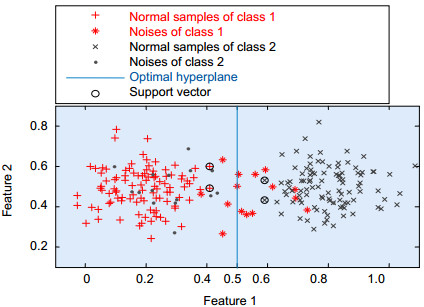


 DownLoad:
DownLoad:
